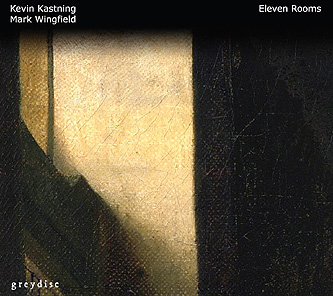 Releasing
a CD every year for the past five years, Mark Wingfield and
Kevin Kastning return to the recording world with the 2015
CD release of Eleven Rooms. Improving with every
album release, the duo hit yet another new high with Eleven Rooms.
There’s always some concept or approach taken with every
one of their album releases, and on the eleven track Eleven Rooms,
the concept focuses upon the works of the obscure Dutch painter
Johannes Vermeer (1632-1675). From the liner notes of Eleven
Rooms, the duo add, “For most of the pieces on this recording,
we placed prints of Vermeer’s paintings in front of us while
we recorded.” While all of the albums by Wingfield and Kastning
have certain similar sonic elements of surprise, perhaps the most
illuminating aspect on Eleven Rooms is the excellent sound
quality they achieve in Kastning’s Studio Traumworld in the Boston
area, while Wingfield deftly handles the mixing and mastering in The
Gravity Factory in the U.K. Renowned for his avant garde excursions
that feature custom guitars, with astronomical amounts of strings,
Kastning’s guitar setup is relatively modest here with the CD
featuring his 36 string Double Contraguitar, the 30 string Contra-Alto
guitar, 6 string classical guitar and mandolin. The mandolin sound,
unheard on earlier albums, adds in yet another new sonic texture and
in and of itself it adds in a kind of impressionistic Americana sound
in places. On the fast track towards becoming a world renowned jazz-rock
fusion electric guitarist Wingfield, fresh from his 2014 album Proof
Of Light, sounds quite energized throughout Eleven Rooms, never
dominating the soundstage or over saturating the audio spectrum—instead
adding sonic depth, with ample reverb that brings towering drama to
Kastning’s geometric, multi-string mosaics. Even with a string
of fine albums already released by this guitar team, it’s worth
restating that Eleven Rooms is the best sounding and most revealing
album yet from Kevin Kastning and Mark Wingfield. www.KevinKastning.com
/ www.MarkWingfield.com
Releasing
a CD every year for the past five years, Mark Wingfield and
Kevin Kastning return to the recording world with the 2015
CD release of Eleven Rooms. Improving with every
album release, the duo hit yet another new high with Eleven Rooms.
There’s always some concept or approach taken with every
one of their album releases, and on the eleven track Eleven Rooms,
the concept focuses upon the works of the obscure Dutch painter
Johannes Vermeer (1632-1675). From the liner notes of Eleven
Rooms, the duo add, “For most of the pieces on this recording,
we placed prints of Vermeer’s paintings in front of us while
we recorded.” While all of the albums by Wingfield and Kastning
have certain similar sonic elements of surprise, perhaps the most
illuminating aspect on Eleven Rooms is the excellent sound
quality they achieve in Kastning’s Studio Traumworld in the Boston
area, while Wingfield deftly handles the mixing and mastering in The
Gravity Factory in the U.K. Renowned for his avant garde excursions
that feature custom guitars, with astronomical amounts of strings,
Kastning’s guitar setup is relatively modest here with the CD
featuring his 36 string Double Contraguitar, the 30 string Contra-Alto
guitar, 6 string classical guitar and mandolin. The mandolin sound,
unheard on earlier albums, adds in yet another new sonic texture and
in and of itself it adds in a kind of impressionistic Americana sound
in places. On the fast track towards becoming a world renowned jazz-rock
fusion electric guitarist Wingfield, fresh from his 2014 album Proof
Of Light, sounds quite energized throughout Eleven Rooms, never
dominating the soundstage or over saturating the audio spectrum—instead
adding sonic depth, with ample reverb that brings towering drama to
Kastning’s geometric, multi-string mosaics. Even with a string
of fine albums already released by this guitar team, it’s worth
restating that Eleven Rooms is the best sounding and most revealing
album yet from Kevin Kastning and Mark Wingfield. www.KevinKastning.com
/ www.MarkWingfield.com
mwe3.com presents a new interview with
Kevin Kastning & Mark Wingfield
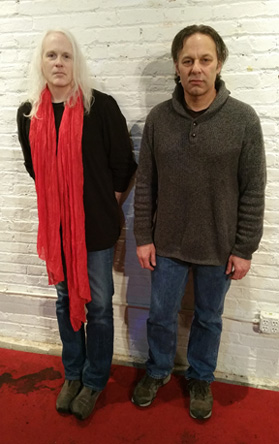 mwe3:
Eleven Rooms is the fifth album by Kevin Kastning and Mark
Wingfield. When you first met did you think your working relationship
would have such long legs? When was Eleven Rooms recorded?
I think it’s your best-performed and best-recorded album yet.
Anyway, it sounds great on my vintage gear from the late 1980s and
early ‘90s so I think you’ve finally bridged that vintage
sonic gap with style! Did you set out to record your finest yet?
mwe3:
Eleven Rooms is the fifth album by Kevin Kastning and Mark
Wingfield. When you first met did you think your working relationship
would have such long legs? When was Eleven Rooms recorded?
I think it’s your best-performed and best-recorded album yet.
Anyway, it sounds great on my vintage gear from the late 1980s and
early ‘90s so I think you’ve finally bridged that vintage
sonic gap with style! Did you set out to record your finest yet?
Kevin Kastning: Hi Robert. Mark and I first worked together
on the album I walked into the silver darkness, which was recorded
in 2010. At the end of those recording sessions, we both agreed that
we'd like to do an album project per year, and here we are six years
later with the release of our fifth album, with the sixth one in the
can. Eleven Rooms was recorded in July 2014. And to answer
your other question: every time we're in the studio we set out to
record our finest one yet. I think each record of ours has gotten
stronger than the one preceding it. Thanks for the kind words about
the recording quality. The actual recording sessions were set up about
the same as our previous ones. Mark did the mix and mastering, and
had some new tools at his disposal, and to my way of hearing, I think
this is probably our best-sounding record. He did an outstanding job.
Mark Wingfield: I think I knew we would be working together
into the future after our first session for our first album. What
happened at the first session was for me, totally unique musically
and I knew we had just scratched the surface. I think as time has
gone on we have gone deeper into what we started on the first album.
Thanks for your comments on the recording quality. We do work hard
to achieve great quality recordings and I make every effort to preserve
or even enhance that during the mixes. A handful of the top software
designers have been advancing so much in the past two or three years,
to my ears it has at this point surpassed the sound of analog. In
fact some of the latest software can go well beyond hardware in terms
of enhancing the sound in the very ways hardware is famous for, only
without all the compromises and downsides of using hardware. This
makes it a lot easier for me when mixing and mastering to get a richer,
more organic sound. I think this revolution in audio, in conjunction
with the new international loudness normalization standards are going
to mean a huge improvement in audio quality and realism.
mwe3: Were there any new guitars or recent gear / instruments
used during the creation of Eleven Rooms? I want to ask about
specific tracks from Eleven Rooms and perhaps Kevin wouldn’t
mind telling us why he chose what guitar for each track, especially
as he has several featured and the mandolin too, which we would also
like to hear about. Mark is just listed on the electric guitar here,
which will no doubt intrigue fans as to what guitar or guitars he’s
using. Were you recording direct in or were you using amps on the
new CD? Any changes or processes in the recording setup this time
around?
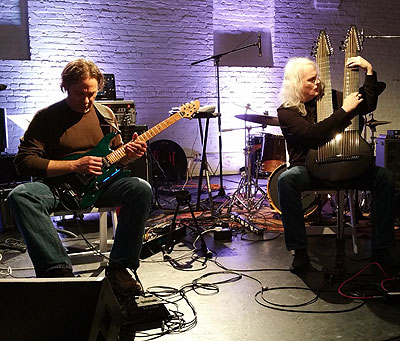 Kevin
Kastning: For Eleven Rooms, we based each piece on a painting
by Johannes Vermeer. We did some diagramming and in-depth discussion
for each piece. I selected the instrument based on the painting and
wanted to match the textures of the instrument and its tuning to each
Vermeer. There were a couple of his paintings that seemed to want
to be on mandolin, which is an instrument I rarely use in the studio.
In fact, I think this is the first time I've used it on a Greydisc
recording. Regarding the recording studio, there were no real changes
from our usual studio setup.
Kevin
Kastning: For Eleven Rooms, we based each piece on a painting
by Johannes Vermeer. We did some diagramming and in-depth discussion
for each piece. I selected the instrument based on the painting and
wanted to match the textures of the instrument and its tuning to each
Vermeer. There were a couple of his paintings that seemed to want
to be on mandolin, which is an instrument I rarely use in the studio.
In fact, I think this is the first time I've used it on a Greydisc
recording. Regarding the recording studio, there were no real changes
from our usual studio setup.
Regarding the instruments I selected for each piece, I used my two
main instruments: the 36-string Double Contraguitar, and the 30-string
Contra-Alto guitar on most of the album. I used 6-string classical
guitar on "A Balance in Light I & II," and mandolin
on "The Slumber" and "The Allegory of Painting."
I used the instrument that I felt would best capture or illustrate
the painting on which the individual piece was based.
Mark Wingfield: My setup was the same as previous albums. I
was using a Roland VG-88 and a laptop. The VG, which is a guitar processor
not a synth, provides the basis of my sound. I then use the laptop
to augment that using filters, reverbs and other enhancements. Unlike
some of our previous albums, I didn't use any synth or samples on
this album. It's all just electric guitar. In fact, what's slightly
unusual for me on this album is that on some of the tracks I played
with a completely clean guitar sound. It just seemed right for the
music and the feeling of the session. My Patrick Eggle LA guitar is
the only one I currently use for recordings and live work though I
have other guitars I practice on.
mwe3: It’s interesting that Kevin decided to play the
mandolin on Eleven Rooms. What does the mandolin add to the
mix and what tracks was the mandolin more featured on? Tell us about
the mandolin as you haven’t used it before on record right? For
instance on the first track on the CD, “A Letter At A Window:
Opening” is there a kind of Americana feel to the music? Is that
a kind of different sound for you in that Mark’s electric guitar
playing sounds a little different?
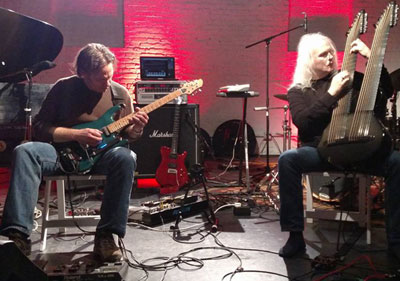 Kevin
Kastning: I did use it on a record project back around 2001 -
2002, but those were radio-only recordings and were never released.
For this project, it just seemed to fit a couple of the paintings;
it helped to translate what I heard in the paintings. It is a sparser
voice with a very limited register. There was certainly one piece,
"American Midwest: Touch" about which Mark felt very strongly
that to his way of hearing was about the American midwest; hence that
title. On the surface, it might seem unrelated to the Vermeer works
on the record, but it was recorded at the same sessions and we both
felt that it was very connected to the other pieces, so that's why
it was included on the album.
Kevin
Kastning: I did use it on a record project back around 2001 -
2002, but those were radio-only recordings and were never released.
For this project, it just seemed to fit a couple of the paintings;
it helped to translate what I heard in the paintings. It is a sparser
voice with a very limited register. There was certainly one piece,
"American Midwest: Touch" about which Mark felt very strongly
that to his way of hearing was about the American midwest; hence that
title. On the surface, it might seem unrelated to the Vermeer works
on the record, but it was recorded at the same sessions and we both
felt that it was very connected to the other pieces, so that's why
it was included on the album.
Mark Wingfield: What I found interesting about this session
is that it was inspired by the paintings of the Dutch artist Vermeer.
We had books with prints of the paintings open in front of us as we
played the session. Yet, as you point out there is a feeling of Americana
in some of the tracks. I can't explain that exactly, except that it
was just there, it's what I felt in the music during the session.
Perhaps it is that some of the things in Vermeer's paintings are universal
and so we interpreted them through our own cultural lens and experience.
Although I have spent much of my life in the UK, I was born in the
US and have spent a significant amount of time there especially in
childhood and young adulthood. So a core part of me is and always
will be American. Yet at the same time another major part of me is
English, I've spend most of my life in England, my wife is English,
my mother is English, and my dad is American.
For most of the tracks we decided to theme the titles on the paintings
which inspired each piece. For track two however, I felt we really
needed to depart from that and specify the American feel. Having said
that, I think that although the titles are inspired by various Vermeer
paintings, in another way they could just as easily relate to scenes
of life in American or anywhere else.
mwe3: How did it occur to you to include, as influences, the
paintings of Johannes Vermeer, who lived in the mid 17th century?
What paintings of Vermeer were you most intrigued by and how does
his work compare to some of the other influences featured on your
other albums? Are the track titles in direct reference to Vermeer’s
paintings and what can you tell us about the cover art?
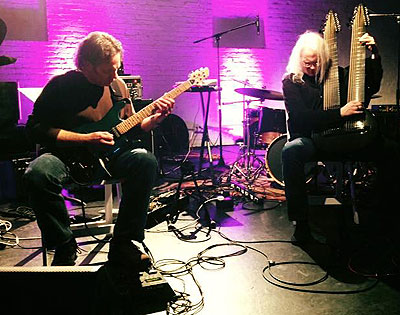 Kevin
Kastning: I have been a fan of Vermeer's work for many years.
For me, it's not just about what he has painted, but so many of his
works seem to illustrate a secret story; it's alluded to, but never
blatantly represented. For me, this is really strong and very moving.
A couple of years ago, I was reading a book about his paintings and
his technique. His control of and use of light in his paintings just
knocks me over.
Kevin
Kastning: I have been a fan of Vermeer's work for many years.
For me, it's not just about what he has painted, but so many of his
works seem to illustrate a secret story; it's alluded to, but never
blatantly represented. For me, this is really strong and very moving.
A couple of years ago, I was reading a book about his paintings and
his technique. His control of and use of light in his paintings just
knocks me over.
The more I looked at his paintings, the more I could start to hear
textures in them. I knew I wanted to do a project based on or involving
his works. I thought about doing this as an album concept with Mark,
and I spoke with him about it and asked if he would be interested
in using that as a concept for one of our records. He was very interested
in it, so we booked it. A few months before the recording sessions,
I suggested we select a handful of Vermeer's paintings that spoke
to us, so we agreed on a list of works on which to base our pieces.
I then asked him to make a diagram of how he hears various elements
in our list of selected paintings, and I did the same.
When we arrived in the studio, we compared our diagrams and notes
and created a third list, which was the painting elements upon which
we'd agreed do translate into compositional elements. We both had
books of Vermeer's paintings, so we both had the painting on which
we were working in front of us while tape was rolling. Yes, the titles
are based on the painting represented by that track. We didn't want
to use the exact painting titles, but instead only referred to the
actual paintings in the track titles. The cover art is by Vermeer;
it is a very tiny detail from, I believe, "The Music Lesson."
I loved how it captures his grasp of and use of light; yet it was
juxtaposed against a shadow. There are times where I hear the music
of Mark and I just like that, and we both agreed that this detail
of his painting was a good representation of the overall feel of this
record.
Mark Wingfield: This was originally Kevin's idea. We have discussed
the work of numerous painters over the years and both like a wide
range of different genres of painting. We had discussed the Dutch
masters on various occasions and both felt a strong resonance between
their approach to light, shadow, the inner stories contained in the
paintings and our ideas about music. So when Kevin suggested the idea
that we use Vermeer's paintings as inspiration for our next album
I thought it was a great idea. We usually look for a new approach
to each album we do together. Often these ideas are too abstract or
difficult to relate directly to the album title or liner notes. However
in the case of this album and Dark Sonatas, which was inspired
by the composer Eliot Carter, it made sense to explain the inspiration.
mwe3: What inspired “American Midwest”? There seems
to be that wide open spaces effect with some great twangy bass notes
on Kevin’s acoustic and Mark’s fusion guitar sound comes
into play.
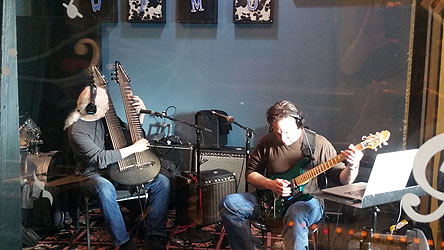 Kevin
Kastning: Now I'm not even sure on which Vermeer painting that
piece was originally based, but we just followed where it led when
we recorded it. During post-production, Mark said he heard a very
strong element of the American midwest in it. I am originally from
the American midwest; fact, I grew up there, and I knew to what he
referred in the piece and I knew what he was hearing in it that had
that connection. It is that wide-open spaces element that you're hearing
on which the piece is based and why it has that title.
Kevin
Kastning: Now I'm not even sure on which Vermeer painting that
piece was originally based, but we just followed where it led when
we recorded it. During post-production, Mark said he heard a very
strong element of the American midwest in it. I am originally from
the American midwest; fact, I grew up there, and I knew to what he
referred in the piece and I knew what he was hearing in it that had
that connection. It is that wide-open spaces element that you're hearing
on which the piece is based and why it has that title.
Mark Wingfield: This track just went in that direction. For
me it was something about what Kevin was playing, the combination
of those incredible bass notes, the rhythm and the chords he plays
in the higher register. I just saw the western plains, the houses,
the back yards, the lives, the distances, and even the cities. So
I played what I saw, all those places and lives and the piece just
went completely in that direction. That's why I wanted to make the
title reflect that, even though it departed from the other titles
somewhat. This piece has such a strong and specific feeling to me
that I felt it was important that the title had a connection with
what the piece was about.
mwe3: “The Slumber”, track 3, is one of the tracks
with mandolin. Does the mandolin have a kind pizzicato effect? Is
that track a kind of avant garde lullaby as there’s a kind a
restful effect from the track.
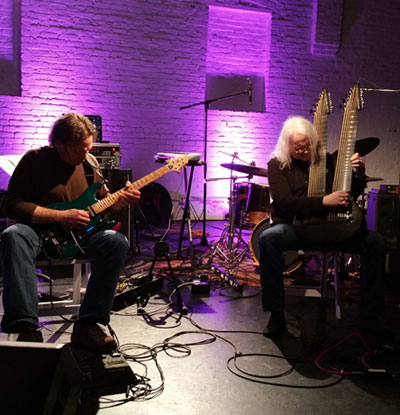 Kevin
Kastning: That piece was based on a Vermeer painting where a woman
is at a table and has fallen asleep. It's a very strong work, and
we tried to capture that sense of calm in it. I felt the mandolin
brought a kind of delicate austerity and space to the piece.
Kevin
Kastning: That piece was based on a Vermeer painting where a woman
is at a table and has fallen asleep. It's a very strong work, and
we tried to capture that sense of calm in it. I felt the mandolin
brought a kind of delicate austerity and space to the piece.
Mark Wingfield: I can see the painting quite clearly when I
listen to this piece because I remember very clearly the feeling I
got from the painting while playing. As Kevin says, there is such
a sense of calm in the painting and at the same time the woman seems
to be almost joyous in her sleep or her dreams. That's the feeling
I tried to capture and it did become a sort of lullaby.
mwe3: What made you decide to make “A Letter At A Window”
into a three part recording? Tracks four “A Letter At A Window:
Message” and five “A Letter At A Window: Epilogue”
feature an extension of “Letter At A Window: Opening”. How
do the three tracks kind of fit together as a trilogy? Is there a
meaning behind the 3 titles? Part 3, track 5 has some pretty intense
guitars from Mark that don’t even sound like guitars.
Kevin Kastning: I think the painting’s actual title is
"Woman In Blue Reading A Letter." We felt that this painting
was so strong, both in artistic content and in the secret story element
I previously mentioned, that during the recording sessions, we weren’t
sure we’d captured what we’d intended. We really wanted
to try to represent the story, as well as the fantastic sense of light
and mood Vermeer established there. So we did more than one version
of it, thinking that we’d choose the one that came closest to
what we wanted for the painting. However, when we heard the rough
mixes of all three, it was as if each one contained an element of
the painting that the others didn’t. So we decided to include
all three in the hopes of having our complete interpretation or translation
of the painting.
Mark Wingfield: Actually what I'm playing here is just electric
guitar played into a long reverb and echo using a volume pedal. I
think perhaps the way I'm manipulating the pitch at times makes it
sound unusual and less like a normal guitar.
These three tracks share the same title because they were inspired
by the same painting and they seemed to fit together musically as
a trilogy. We didn't have a particular plan to do a trilogy of pieces,
but listening back we felt they worked well in that context.
 mwe3:
“A Shadow And Folding” has two parts that make up tracks
6 and 7. Mark’s sonic sustainer guitar is very much in control
of that track. What’s the inside story of that two part track?
Is Mark using any new sound shapers or sonic devices on “A Shadow
And Folding”?
mwe3:
“A Shadow And Folding” has two parts that make up tracks
6 and 7. Mark’s sonic sustainer guitar is very much in control
of that track. What’s the inside story of that two part track?
Is Mark using any new sound shapers or sonic devices on “A Shadow
And Folding”?
Kevin Kastning: I'll defer to Wingfield on this one.
Mark Wingfield: A couple of times on this track I did briefly
use some sound manipulation on the laptop. I used a wave shaper and
frequency modulator, which I can bring in using pedals or the touch
strip attached to my guitar. However I only used them momentarily
a couple of times on these tracks and very little if at all on the
rest of the album. Most of what you hear is actually just my normal
guitar sound. What may be different is that I am doing some unusual
things with the pitch and vibrato during sustaining notes.
Although my usual sound doesn’t have that much distortion or
overdrive on it, it does have a lot of rich upper harmonics. The particular
pattern of upper harmonics in a given guitar sound is something that
has always interested me. For readers unfamiliar with what I mean
here I'll explain. I'm not talking about playing harmonics on the
guitar, I'm referring to the upper harmonic structure of sound. Any
instrument’s sound can be described in part by it’s unique
pattern of harmonic overtones.
This pattern of upper harmonics is part of what makes an oboe sound
different from a violin or acoustic guitar. Every different guitar
sound or guitar tone has a different pattern or signature of harmonic
overtones. Even within one particular guitar sound, different parts
of the neck will have a different variation of it’s signature
upper harmonic pattern, hence you get different tones playing in different
areas of the neck. How you play will also change that tone.
Once you have a note sustaining for a period of time, which I do using
a sustainer, the note will settle into a version of it’s particular
upper harmonic signature. For me this presents a rich area of expression
because if you vary the pitch during this sustain, you also end up
varying the harmonic overtones of the sound. This means you can manipulate
the tone as well as the pitch. That for me opens up a big area of
things which can be done with different vibrato and pitch bending
approaches. Because you are altering the tone by what you're doing
with the strings, it can in effect become a different guitar sound.
 mwe3:
Track 8 is “The Eighth Room”. Is that one inspired by a
specific Vermeer painting? That’s another very dark sounding
track with lots of sustain and some wild guitar freakouts by Mark.
Is Kevin’s role to hold down the fort here so to speak? Do you
switch roles on different tracks as to who will be the sonic anchor
and who will soar off into the stratosphere? The track does have a
great ending with some pizzicato like string effects and Kevin’s
guitar sounds like a tack piano!
mwe3:
Track 8 is “The Eighth Room”. Is that one inspired by a
specific Vermeer painting? That’s another very dark sounding
track with lots of sustain and some wild guitar freakouts by Mark.
Is Kevin’s role to hold down the fort here so to speak? Do you
switch roles on different tracks as to who will be the sonic anchor
and who will soar off into the stratosphere? The track does have a
great ending with some pizzicato like string effects and Kevin’s
guitar sounds like a tack piano!
Kevin Kastning: It was based on one of Vermeer's works, but
now I'm not sure which. I don't recall how we set up this piece exactly.
Often we will assign roles to ourselves, specify ranges or registers,
maybe thematic elements or harmonic elements and base the piece on
that. Once we get into the piece, we're not necessarily bound by those
guidelines; we just allow the music to come into its own life and
take whatever shape and form it wants. In fact, there are pieces where
we've agreed upon three or four compositional elements; yet the piece
may only utilize one or two of those. The piece itself determines
what it wants and needs.
Mark Wingfield: We don’t tend to specify roles in a piece
but we will sometimes specify registers or the change of registers,
which we might do on a signal while playing. Often we don’t specify
anything apart from discussing instrumentation or perhaps tempo. However
even if we arrange something like registers, we're as likely as not
to abandon the idea at any point during the piece if it feels right.
mwe3: What can you tell us about the two part “A Balance
Of Light 1 and 2”? Is that kind of a cooling down after the more
spatial elements of the earlier tracks? It almost has a New Age feel
to it but I think you guys would probably laugh at anyone using the
terms New Age to describe even your more astral moments! Is New Age
music off the map for you or are you too interested in experimental
and challenging music to rest on your laurels enough to make a kind
of ethereal New Age type album or is anything in the cards? Anyway
the two-part “A Balance Of Light” is quite stately in its
own right!
Kevin Kastning: I think our music is so difficult to categorize
that it may find itself in multiple categories. I don't really mind
that; people hear it and define it as they wish, which is probably
a good thing. I know that for me, when I can sort of find my own way
through a piece of music or a painting and assign my own meanings
to it, or allow it to speak to me on its own terms, it becomes a much
more personal and profound experience for me. I've heard some really
beautiful music that is in the New Age category, so that term or category
doesn’t bother me in the least.
Mark Wingfield: I never think of any of the music I do as being
a particular style or not being a particular style. I honestly think
of it all as just music. I know that sounds glib, but actually it's
exactly how I think about it, what style it might be doesn't come
into my mind. I'm happy for listeners to decide for that themselves
if they feel inclined to. The music I play and compose might at different
times sounds like many things, because that's what comes into my head.
I can’t imagine myself ever settling down to one style or restricting
myself to one style. This isn't because there's anything at all wrong
with doing so, it’s simply that what I hear tends to change a
lot, sometimes even within one piece. My last band album, Proof
Of Light was sometimes talked about in the press as sounding very
"ECM" and was often compared to artists on that label, however
just as often it was compared to progressive rock. Obviously there's
quite a wide range in-between those two styles. But it didn't surprise
me that these divergent comparisons were made. I think I would have
been worried if every review stuck it in the same box. It’s the
same with what Kevin and I do, we don't draw any stylistic lines and
we don’t avoid or peruse any specific stylistic areas… we
simply let the music develop in the direction we hear and feel at
the time.
 mwe3:
Is “The Allegory Of Painting” kind of the epilogue for Eleven
Rooms? Kevin’s mandolin gives the track a kind of haunting
and wistful sound. Is this track a kind of a closing of the doors
to the rooms and the paintings or a way to say goodbye after some
scintillating sonic conversations? So where to now for you as far
as new music and future releases? Tell us about your recent concerts,
where did you play and what music are you playing in these late 2015
shows?
mwe3:
Is “The Allegory Of Painting” kind of the epilogue for Eleven
Rooms? Kevin’s mandolin gives the track a kind of haunting
and wistful sound. Is this track a kind of a closing of the doors
to the rooms and the paintings or a way to say goodbye after some
scintillating sonic conversations? So where to now for you as far
as new music and future releases? Tell us about your recent concerts,
where did you play and what music are you playing in these late 2015
shows?
Kevin Kastning: We didn't intend on it being the final piece
when we recorded it. When we heard the rough mixes of everything,
it seemed to stand out as having a kind of peaceful finality and closure
to it. Nice that you heard it that way, too!
As Mark said, we did a couple of performances in New York City in
December 2015, then spent a couple of days in the studio to record
our next album which will be out in late 2016.
For me, this is going to be a busy year. The new album with Carl Clements
is released on January 26. I just sent the masters for my second solo
album off to the label; that record will be out in late February 2016.
There's a new duo album with Sandor Szabo that will be released this
year, and there are a couple of other projects on which I'm working
which should also be out this year. There is a trio record in the
can of Sandor Szabo, Carl Clements, and me; this will be out in late
2016. The new one with Wingfield will be released also in late 2016.
Mark Wingfield: I decided on the running order for this particular
album and I felt this was a good ending track, it just seemed to feel
right. I'm glad you felt was a good track to end with. In December
we did a couple of concerts in NYC one at Shapeshifter Lab and another
live performance on WFMU.
Following these performances we went into the studio to record a new
album which will be released in 2016. It's a very busy year for me
also. I've just finished playing on Dwiki Dharmawan's new album which
mixes some of the best of London's jazz players with Dwiki's unique
blend of jazz and Indonesian gamalan influences.
I'm also mixing Dwiki's album. I am recording a new band album in
February with Asaf Sirkis and Yaron Stavi as well as an album with
touch guitarist, looper and composer Markus Reuter. I also have a
new album with harpsichordist Jane Chapman and Brazilian percussionist
Adriano Adewale coming out later this year.



